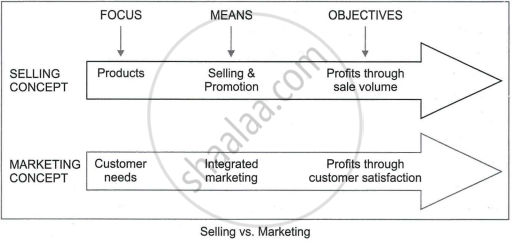Advertisements
Advertisements
प्रश्न
Distinguish between Marketing and Selling.
Distinguish clearly between marketing and sales.
उत्तर १
| Basis of Distinction | Marketing | Selling | |
| 1. | Scope | Total system consisting of planning, pricing, promoting and distributing products. | A part of marketing involving persuasion and directing flow of products to customers. |
| 2. | Beginning | Begins much before goods are produced to understand the needs and preferences of consumers. | Begins after the goods are produced. |
| 3. | End | Continues even after sale so as to provide after-sale service and to judge reactions of consumers. | Comes to an end with the delivery of goods to customers. |
| 4. | Orientation | Customer-oriented, the aim being to satisfy the needs of buyers. | Product-oriented, the aim being to satisfy the needs of the seller. |
| 5. | Focus | On long-term growth and profitability of business. | On short-term maximisation of profits. |
| 6. | Means used | Integrated approach. | Persuasion and promotion. |
| 7. | Objective | Profits through customer satisfaction. | Profits through sales volume. |
| 8. | Principle | Caveat vendor - let the seller beware. | Caveat emptor - let the buyer beware. |

उत्तर २
| Basis of Distinction | Marketing | Selling |
| 1. Meaning | Identifying and satisfying wants. | Exchanging goods for money. |
| 2. Objective | Ensuring growth and stability of the firm - long-term goals. | Maximising profits through increase in sales volume - Short-term goals. |
| 3. Orientation | Customer-oriented, let the seller beware. | Production-oriented, let the buyer beware. |
| 4. Scope | Wider in scope includes selling. | Narrow in scope part of marketing. |
| 5. Beginning and end | Begins before production and continues after sale. | It begins after production and ends with a sale. |
| 6. Focus | External; on customer's needs. | Internal, on seller's needs. |
| 7. Demand | Involves creation and maintenance of demand. | Presupposes the existence of demand. |
| 8. Growth | New and modern concept. | Old and traditional concepts. |
| 9. Approach | Integrated approach for achieving long-term goals. | Fragmented approach for immediate gain. |
| 10. Process | Converting customer's needs into products and services. | Converting products and services into cash. |
| 11. Nature of activity | Philosophy and attitude. | Routine and tactical. |
APPEARS IN
संबंधित प्रश्न
Caveat vendor means ______.
Marketing concentrates on ______.
Write any two differences between Marketing and Sales.
Selling pre-supposes the existence of demand for the firm's product; on the other hand, marketing involves creation and maintenance of ______ demand.
Selling involves ______ of goods and services.
Selling is internally oriented because it seeks to ______ profits through increased volume of sale.
______ begins before production and continues even after sale.
Selling is ______ and ______.
Which of the statements are not true for selling?
"Marketing is customer-oriented whereas selling is producer oriented." Explain.
Marketing is a ______ term than selling.
The latest method of direct selling is ______.
Selling aims at ______.
Marketing is wide term than selling. Justify.
